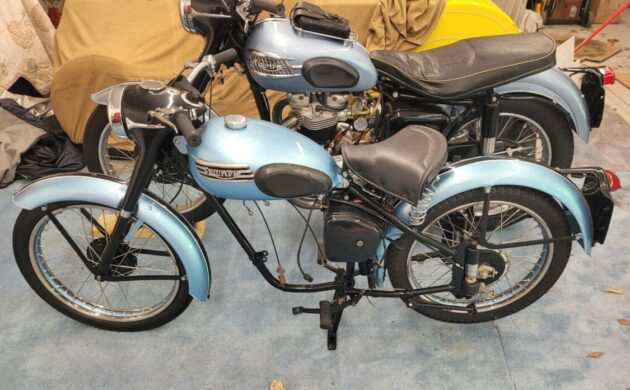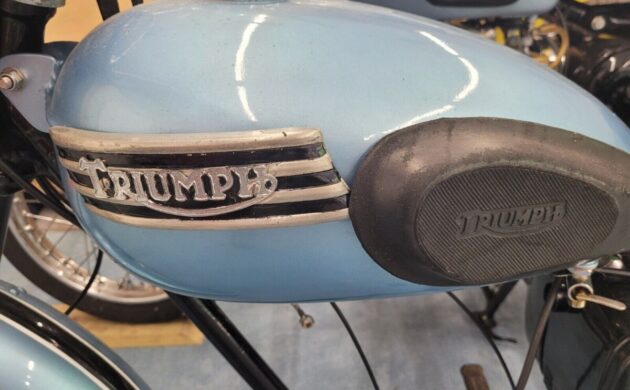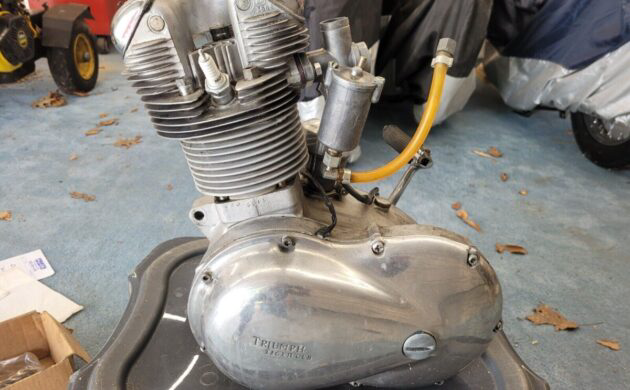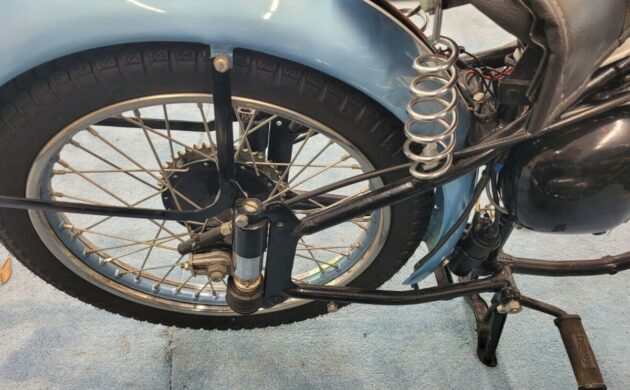I have always wanted a simple bike to potter around the country in. Something simple and easy to work on. Back in the 1950s, they were plentiful and reasonably affordable, and one of the more popular manufacturers was the British company Triumph. As well as producing some great sports cars of the day, they were also producing bikes. Our bike today is for the American market and was part of a range that was produced from 1953 up until 1961. Our 1955 model year comes at us from Williamston, Michigan with just over one day left on the auction on eBay here, and bidding still under $1500.
The Tiger was the fastest model produced by Triumph at the time and built primarily for the American market which wanted more power. Unfortunately, there is some confusion as to the model of this bike as it’s listed as a ‘100’ model, ‘200’ model and ‘110’ model all in the advert. Whatever one is it, the new buyer will need to do some light restoration – mostly to the engine which has been removed but is with the bike. The seller mentions that the bike has been restored in England at one point before the original owner passed away. You will need to find a new exhaust and chain guard as these are missing from the bike.
Luckily the restoration looks like it has been completed to a high specification, with the baby blue paint not suffering any dents or dings. The black frame is also in good condition and ready for that 649cc engine to be installed again. This bike is quite iconic as a modified version of it managed to break to a world speed record on bikes, at 214.17mph at Bonneville and lead to the development of this bike’s famous successor, the Bonneville.
I think bikes are some of the easier projects for amateur mechanics to work on – the simple setup and ease of finding parts means that you could easily get this back on the road after a few hours of effort working on this. You may not be breaking any speed records on this bike, but I think it would be fun to blast around the canyon roads on a piece of history. So do you think you could bring this bike back to life and would it be an easy project for a DIY mechanic?






It isn’t a 650 cc Tiger. Tiger Cub 200, has a 199 cc single cylinder, 10 hp, top speed 65 mph,. …. consumption 100 mpg.. :-)
This is a CUB! Do your research before you write these please.
A two minute check up on Google will tell you all you need to know about this bike. Raoul=F has done his homework. If you compare the down tube of this bikes frame and the down tube of the Tiger 110 in the background you will see that the diameter of this 200 is far too small, and light, to take the weight and power of a 650cc engine.
Triumph made a 150 Terrier and a 200 Cub. This looks a lot like the Terrier. Somewhere in my collection of bike stuff I’ve got a next to new manual for one of those. When I see ads like this I’m tempted to get the bike and the manual closer together…
I always quite fancied putting a Cub engine in a Jubilee rolling chassis and building a rubbish Triton…
“Potter” around with? That’s a new one. Let’s go with the “simple and easy to work on” first,,simple? Not a Limey, where common tools won’t work, engineering that will make even Geomechs scratch his head, and work on it, you will. The result, when everything works right, simply the best ( ferrin) motorcycles made. Depending on if you are a Harley fan, which I am, Limeys are to me, the 2nd best motorcycles made. It’s a great find, $1400 is giving this thing away. Not long ago, a British bike, ANY British bike was highly sought after. This clearly shows, the steam is fizzling on these too. Maybe that Trident isn’t so far out of reach after all.
What grinds my gears, is some of you just can’t wait for an author to post a mistake. Rather than politely correct them, it seems some need to express how smart they are, or how stupid they think the author is, to call that mistake out in a rude fashion. Why is that? Is it our lack of human interaction that would surely in the past, garner a punch in the nose, that allows this today? Pixx poor, sorry,,cool bike.
Says the person who pointed out “potter around” in, when the author clearly meant putter around in.
I appreciate Elliot (the author) for pointing out how easy and rewarding a small motorcycle project could be. I’ve had a few project cars over the years, but I am just finishing up the recommission a ’65 Honda CB160, and it has been a joy. The biggest advantages:
–Takes up so little room
–Weighs a few hundred pounds so it’s easy to wrangle (I bet this Triumph weighs about 300)
–Easy access to all parts of the engine
–Very simple carbs
–Can change the tubes and tires yourself
–Small bikes are perfect for new riders (like myself)
–Great fun even at low speeds
I’ll be using my bike for early Saturday drives on the backroads and getting donuts for the family on Sunday mornings and being the only motorcycle at my local cars & coffee. I hope the new owner of this Tiger Cub does the same.
I remember riding a Cub back in early ’60’s a friend had. It was a cool looking bike but I liked my Yamaha 80 better.
If you want a simple small bike, you cannot do better than a Honda 250 Rebel
I sold my 1986 Honda Rebel 450cc last week. Ex US bike. Also a great, fairly light bike. Now bought a 1999 Suzuki Burgman 250cc automatic as the arthritus in my left hand makes clutch operation painful. This is bike No, 54 since 1956.
The 64-dollar question is why hasn’t the engine been installed? Could it be the wrong engine for the frame?
Great looking bike. Arthritis sucks.
If you want a great 200cc motorbike, find a DKW RT200, an Adler twin, a Hercules with the 200cc Ilo engine cradled in a ´Federbett¨ frame or a Victoria Spring with an electric transmission and a frame which is the essence of futuristic technology. THOSE were technical masterpieces. The Brits, not so much, to put it politely.
“and ready for that 649cc engine to be installed again”(?) I’m glad I’m not kick starting 650 cc thumper! The piston must be 5” across.
The 649cc engine is a parallel twin so each cylinder is only 325cc so is hardly a “thumper.” From memory of my rebuilds I would think that each piston is less than 3″ across.
Solosolo, yeah I get it, but the photo of the engine clearly shows a single cylinder engine…I was being facetious.
The triumph cub is number one on my bucket list of a motorcycle, I want. Why? When I was in jr. high school , in Colo you cuould leagally ride a motor scooter at 14 years old. The main regulation was it had to be under 6 H.P. The Tiger Cub was granted that exemption. Only problem was they were expensive, around $600.00. Only the rich kids could afford them. But I had a few rich friends and they let me ride there’s. I just have never got over wanting one, even though I had a 650 Bonneville ,when I was about twenty years old. Now that I am aiimost 80 years old maybe I could get a Tiger Cub and cruise around the retirement community.
“… maybe I could get a Tiger Cub and cruise around the retirement community.”
Please do. Nothing could be cooler.
Bonus! Nothing would upset the HOA board more than Joe having fun on an old bike. *clutches pearls* Good heavens he’s working on it in his driveway!
I had a cub when I was 14 or 15 yrs old , rebuilt and painted it . Had fun , I wish I still had it . Mine was a trials bike . I found that out after the motorcycle dealer bought it . I think mine looked different and had a detachable point cover on the left side IIRC. Long time ago .
Ps my dad was a mechanic and my uncle had a body shop ,so saying I did the work was me just remembering the cleaning and sanding work . They did the technical work .
The crew were a bit scathing of the 650 engine going back into the small frame. I’ve a couple of early bikes and I potter around fettling them then potter around in the back roads. The blue twin in the background would be a better proposition for keeping up with traffic.
I rebuilt my 650 BSA Thunderbolt and it was easy. Had a Triumph Tiger 500 too.
Good bikes but low horse power and small frames.
Bob
biggest problem with a English bike, Lucas Electrics
Actually Rick, I have owned many British bikes and the only electrical problems I had were with the coil, magneto or distributor, none of which were manufactured by Lucas, the so called Prince of Darkness by Americans and King of the Road by Brits. I never had any trouble with the wiring, relays, switches, connections etc.
Over the years I’ve heard lots of jokes about Lucas electrics. I’ve shared a lot of them too. But after owning a series of British bikes and an MGB, plus working on vehicles so-equipped, I’ve come to realize that Lucas electrics are DIFFERENT. I’ve repaired/replaced shorted-out electrical systems in a Land Rover then turned around and repaired/replaced shorted-out systems in a GMC 6500. Oh, the terminology gets a little skewed: “Earth to frame?” What the devil color is “LIGHT, MEDIUM, or DARK?” Then there’s International with them all BLACK, and numbered. Then there’s the Germans with “DER NEU BOSCH MAGNET” amongst other things. I think Kurt Hendricks said it quite well in the book, Motorcycle Electrics Without Pain, and I quote: “The Japanese are kind enough to label their wiring diagrams in English, while the Germans arrogantly label theirs in German, and the British label theirs in Martian.” Close quote. All you need to do is get your head wrapped around where that system came from. That Three-Position switch, “Smoke, Smolder, and Ignite,” translates into many languages. Now back to the Lucas jokes…
Agree with Solosolo, in my 50yrs. of motorcycle ownership most Lucas electrics were dependable.Problems were caused by less than shoddy wiring “improvements”.
I potter around in the garage and putter around on the road which is to actually bimble if you’re brit biking.
I purchased a 1957 TWN (Triumph) BDG125L last month. Very similar to this 200. I am still researching these machines, but mine was one of the last built in the factory in Germany. After the 1956/57 run, the factory was sold to Grundig, for the manufacture of radios. https://cybermotorcycle.com/marques/twn/twn-bdg125.htm
Triumph Nürnberg was no relation to Triumph Coventry. Originally a German i mmigrant founded Triumph Coventry in the 1870´s. In 1900 he returned to his home town (Nürnberg) and founded a sister company. During the 1920´s, that company built bikes using engines from Coventry- The engines proved troublesome and almost bankrupted the company since Triumph Coventry refused to honor their contractual obligations. Consequently, Triumph Nürnberg severed all relationships and built their own engines – small 2 strokes to fit the demand of the mas
rket place. In 1939 they came out with a 250cc bike which formed the backbone of the Wehrmacht courier corps due to its bullett proof design.. After the war, starting in 1949, they came back on the market with a vengeance. Their 350cc Boss 2 stroke (with valves) and 4 mufflers was possibly the most advanced bike of its times (as far as 2-stroke engine technology goes). This bike was so silent, it was more of a ghost in traffic than anything else, albeit very expensive and consequently no sales success. It was in the ´50´s that they marketed their bikes internationally under the nomer TVN (Triumph Werke Nürnberg). This was done due to international pressure, not to use their given name. At the end of the 1950´s this make disappeared from the market along with the rest of the German motorcycles, at lleast those of note.
Thank you, Gerard, for that. Do you have any links to two strokes with valve actuation? An interesting concept.
Sorry schooner, I don´t have a link or any information on it. Many years ago I read about it in a German magazine. All I remember is that it´s a complex system. I think Austrian Puch used it as well, with their single cylinder-double piston 250. Come to think of it, the Triumph Boss too had twin pistons housed in a single cylinder.
Yep, my ’67 Puch 250 has the “twingle” cylinder. Interesting setup, as both pistons move on the same stroke. My ’57 TWN also is of a twingle design.
https://nationalmcmuseum.org/2017/06/23/1965-allstate-sgs-250-twingle/